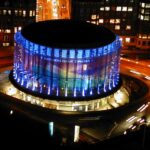We’re all about standards at iDetic, and often we need to educate our clients on what’s required to attain the standards.
For projection systems, the standard has pretty much been 16fL (Foot Lamberts) since SMPTE released their ST 196 standard way back in 2003. Comparatively, 16fL equates to 55 cd/m² (or nits for our TV brethren).
Fast forward 19 years and times have changed! Most standards organizations are finalizing their latest iteration, and the consensus is that more light on the screen is better.
SMPTE Cinema Standard is 16fL
IMAX Cinema Standard is 20fL
Dolby Cinema Standard is 14fL for SDR, and 32 for HDR
Barco Recommends 20fL for SDR, and 40 for HDR
DCI’s Latest Recommends 87.6fL for HDR
How do we get there?
Projection is quite simple: The larger the screen, the more light is needed to fill the screen. Let’s look at a practical example:
Let’s say we’re sitting 4.5m away from a cinemascope screen (2.35 aspect ratio). CEDIA CEB23 (also being rewritten) recommends a screen size of 156″, which works out to a surface area of 61 ft². With today’s resolutions, many consider this small. The equivalent 1.78 screen is 125″ with a surface area of 46 ft². It’s important because most projectors have a native aspect ratio of 1.78 (16:9).
In a perfect world, the calculation would be as simple as multiplying our target luminance with the surface area: 40 fL * 61 ft² = 2440 Lumen output required.
We, unfortunately, don’t live in a perfect world. Let’s examine the factors affecting projector light output.
The legendary Epson TW9400 has a rated light output of 2600 lumen when the lamp output is set to high and picture mode to Dynamic. Both settings are impractical from a noise and image quality perspective. Let’s have a look at the light output in various picture modes:

Typically we leave them in Medium Power / Natural Picture modes to supply the best balance between Noise, Light Output and Picture Quality.
With that being the major contributor to light loss, here are the others to be considered:
- Zoom Factor: +/- 10%
- Throw Distance Loss: -10%
- Port Glass: -2% (For a good one)
- Acoustically Transparent Screen: -10% (Can be up to -25%)
- Calibration: -10%
In our example with the Epson TW9400, let us subtract only 30%, which means we can expect 1083 lumens distributed over 46 ft², which means the predicted luminosity is 23.5 fL.
There are a few ways to compensate:
- Upgrade the Projector
- Reduce the Screen Size
- Make sure the projector is as close to the screen as the ratio will allow
- Use a higher gain screen (Even though it comes with viewing compromises)
To add insult to injury, our example only considers projecting a 1.78 (16:9) image onto a Cinemascope (2.35) screen, leaving bars to the left and right. Using the Zoom method for filling up the entire 61 ft² screen, another 33% of light output is lost due to disuse of a portion of the projection LCD/LCoS/DMD, and another estimated 10% due to zooming out, bringing the total light luminance on the screen to only 13.1 fL!
There are two ways of minimizing this light loss:
- Use a 3ʳᵈ party anamorphic lenses – Predicted 16 fL on screen
- Use a native cinemascope projector
The loss seems excessive, right? Here is a calibration we performed last year to showcase that this calculation is very optimistic with the TW9400!

Estimate: 42 fL
Reality: 31 fL
Note: Bulb based projectors tend to have more light loss (especially over time), which is one of the reasons we tend to avoid them.
What is required then to hit our “modest” 40 fL target? We would recommend a native cinemascope projector (Barco being the only one we know of) with a light output of around 4000 lumens.





